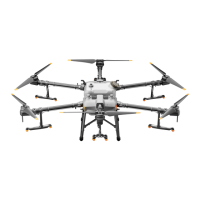wind direction, temperature, and humidity. Consider all factors when using pesticides, but DO NOT compromise
the safety of people, animals, or the environment in doing so.
8. DO NOT contaminate rivers and sources of drinking water.
Sprinklers
1. Avoid using insoluble pesticides such as wettable powder.
2. The sprinklers are delicate parts. Clean them immediately after use.
3. DO NOT bend the hose in an arc tighter than its minimum bend radius. This is to avoid creasing, which may
compromise the spraying effect.
4. Make sure to securely tighten the hose nuts to avoid liquid leakage
Spray Tank
1. Make sure that the spray tank is firmly in place to avoid liquid leakage.
2. The spray tank load must not exceed the specified max value. Refer to the specifications of each aircraft model
for more information.
Spherical Radar System
Warning
To avoid component malfunction, serious injury, and property damage, observe the following rules:
1. DO NOT touch or let your hands or body come in contact with the metal parts of the radar module when
powering on or immediately after flight as they may be hot.
2. Maintain full control of the aircraft at all times and do not rely on the radar module and DJI Agras app. Keep the
aircraft within VLOS at all times. Use your discretion to operate the aircraft manually to avoid obstacles.
3. As shown in the figure below, the omnidirectional digital radar has a horizontal obstacle detection range of
360° and a vertical obstacle detection range of ±15° while the detection distance range is 1.5 to 30 m. Note
that the aircraft cannot sense obstacles that are not within the detection range. Fly with caution. For the four
gray areas in the figure, the detection performance of the radar module may be reduced due to the obstruction
of the frame arms and landing gear. Fly with caution. The effective detection distance varies depending on the
size and material of the obstacle. When sensing objects such as buildings that have a radar cross section
(RCS) of more than -5 dBsm, the effective detection distance is 20 to 30 m. When sensing objects such as
power lines that have a RCS of -10 dBsm, the effective detection distance is approximately 15 m. When
sensing objects such as dry tree branches that have a RCS of -15 dBsm, the effective detection distance is
approximately 10 m. Obstacle sensing may malfunction or be invalid in areas outside of the effective detection
distance.
4. When mounting the omnidirectional digital radar, make sure the arrow mark is pointing towards the aircraft
front.

